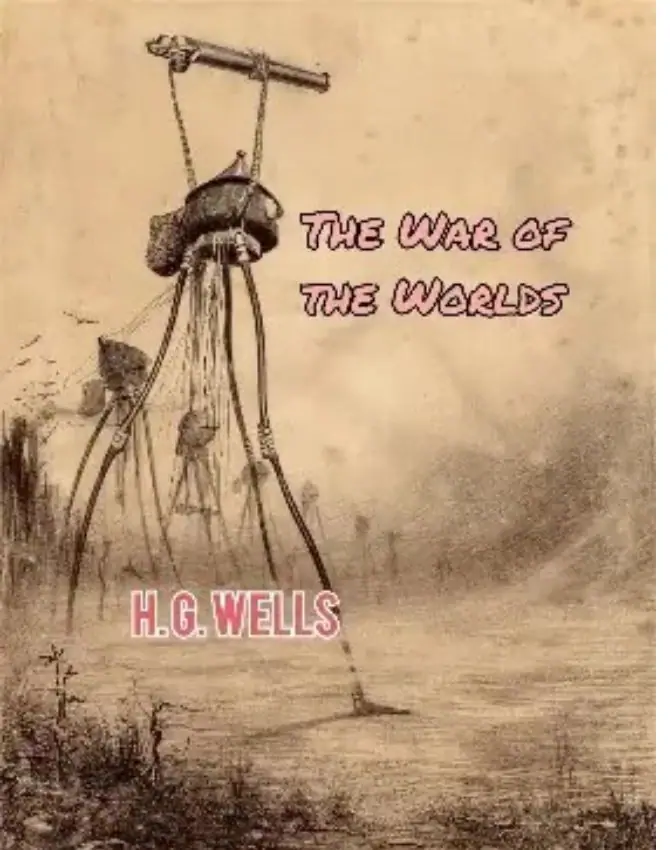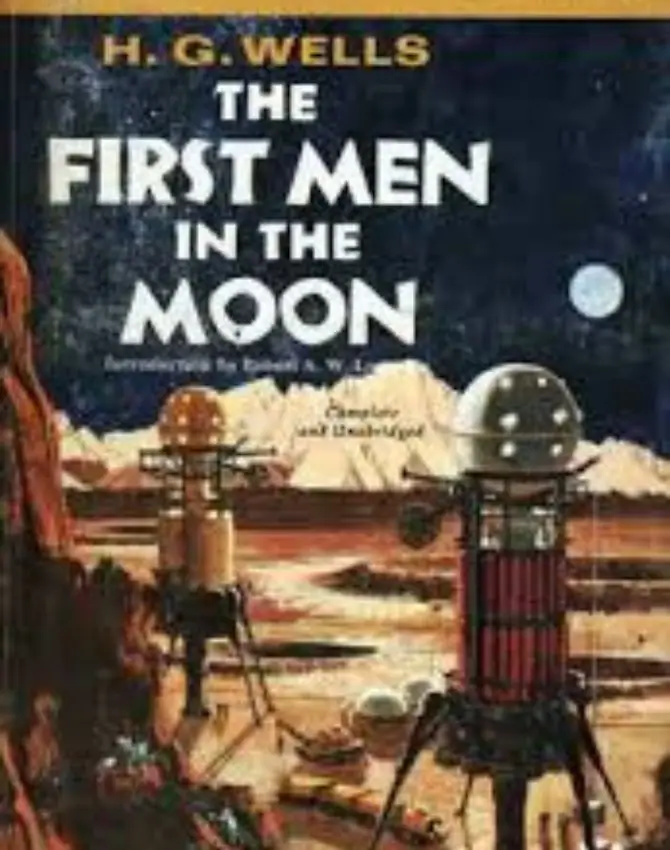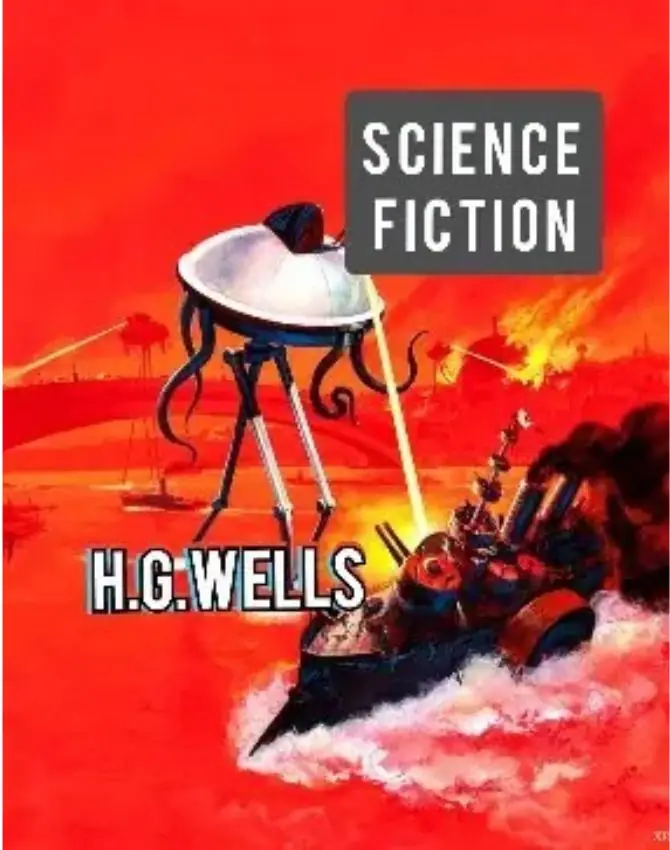H. G. Wells (1866 – 1946)
Herbert George Wells, born in 1866, was educated at Midhurst Grammar School. He took his Bachelor of Science degree at college, taught for a time, but he never pretended to have any great scientific ability. Indeed, one has the impression that pure science bored him. He was interested mainly in its effects upon human society, and this may be why he drew up his plots in a way which would have been frowned upon by Verne.
Though it is sometimes said that H. G. Wells was the English Verne, no two men could have been less alike, and to compare them is unfair to both. From a purely literary point of view, Well’s influence was probably greater than Verne’s, but nearly all his science fiction stories were written early in his career, and in later life he more or less abandoned them.
Wells in his early phase was a story-teller first and a technician afterwards. He wrote more than fifty novels and dozens of short stories. To him scientific accuracy was of secondary importance so long as the tale held together and sounded plausible. Science fiction or Scientific Romance as Wells himself termed it, is useful for such imaginative play because it offers a wider range of situations and images than does conventional realistic literature, and it permits new and eccentric orderings of old images. Wells is now best remembered for his science fiction novels and has been called the “father of science fiction”.
Collection of Science Fiction of H. G. Wells:
The core of work that most interests us today was all published before 1900. It consists of four novels – The Time Machine (1895), The Island of Doctor Moreau (1896), The Invisible Man (1897), The War of the Worlds (1898) and three collections of stories – The Stolen Bacillus and Other Incidents (1895), The Plattner Story and Others (1897), and Tales of Space and Time (1899). This body of work forms a coherent unit which, despite the variety of ingenious plots and situations, is the product of a consistent imaginative method.
Critical Analysis of H. G. Wells Science Fiction
The Plattner Story H. G Well’s Science Fiction
“The Plattner Story” itself introduces the idea of a world occupying the same ‘space’ and ‘time’ as our own, but existing in a different dimension, so that it can have no communication with ours. Gottfried Plattner, an inoffensive preparatory-school master, is blown into this other world by a mild explosion during chemistry class, and is restored nine days later by a second explosion. It is a nightmare picture that H. G. Wells paints; a picture of a shadowy, eerie existence among the strange “Watchers of the Living”, unseen and unapproachable.
Moreover, it is so well done that when we finish the story we are almost inclined to believe that such things might happen. “The Plattner Story”, in which Gottfried Plattner disappears into a parallel world and then later reappears, ornaments the two world structure by raising the issue of fraud (is Plattner perpetrating a hoax?), by making the other world that of the dead rather than just some other ‘space’, and by hinting at a complicated plot at the end. But as in the other tales of this type, nothing develops from these suggestions, and ultimately they are secondary to the dichotomy between the two worlds and the odd intimacy between them.
The Crystal Egg H.G. Well’s Science Fiction:
Few themes of modern science fiction were not anticipated by Wells. As we have been, he did not neglect the inter-planetary plot, and two of his early short stories are of particular interest. In “The Crystal Egg” he describes how an elderly naturalist discovers a glassy stone which possessed strange properties, since by looking into it one could see a curious landscape populated by winged, quasi-human creatures and lit by two moons.
Well’s description of the Martian scenery is brief but graphic, and further complications are avoided by the convenient loss of the egg. “The Crystal Egg”, though it hints at plots tangential to the central structure of physical contrast (Mr Cave’s unhappy home life and the mysterious customers who want to buy the crystal egg lead one to seek some value in the Martian World viewed in the egg) is at its core exactly like ” Davidson’s Eyes”.
The crystal egg is the device, like the mysterious twist to Davidson’s sight, that links London and a strange landscape.
The Star H. G. Well’s Science Fiction:
The other story, “The Star”, concerns the havoc caused when a blazing sun from outer space invades the Solar system, melting the polar ice-caps and decimating mankind by causing earthquakes, tidal waves, and torrential storms. Wells does not do more than mention what he calls “the new brotherhood” which sprang up between the survivors, but we can see his social preoccupation clearly enough, and the moral of the story is obvious. He used the same theme later in his long novel “The Days of the Comet”.
The War of the Worlds H. G. Well’s Science Fiction:
“The War of the Worlds”, Wells’ other great interplanetary novel, appeared three years before “The First Men in the Moon”, and here for once we have story that is nothing more than a story. It begins with the observation of some strange spurts of flame from the disk of Mars.
Some weeks later a strange missile lands in Horsell common, near working, and proves to be a space-craft from the Red Planet, piloted by grotesque monsters who plan to conquer the Earth. The Martian lack of goodwill is shown in no uncertain manner when a terrestrial deputation, marching up behind a white flag of peace, is effectively toasted by an all-destroying heat-ray.
Equipping themselves with mechanical Fighting Machines, the Martians soon overcome humanity’s futile attempts at resistance, only to be destroyed in their turn by putrefactive and disease bacteria which their bodies are not able to combat.

The War of the Worlds is a magnificent story, told with all Wells’ brilliance and power. Yet in the long run it had unhappy repercussions. It introduced the ‘menace to Earth’ theme which has obsessed science-fiction writers ever since, and it sowed the seeds of the popular picture of a horrific Martian.
Wells’ description of the unpleasant visitors leaves little to the imagination. They are bug-eyed monsters, and nothing but bug-eyed monsters; they are, infact, the parents of all subsequent bug-eyed monsters, of which there have been many. Descriptions of the habits and customs of these beings can hardly make savour reading, and although Wells kept up interest without stressing the squalid and disgusting, his less gifted disciples have been unable to do so.
The First Men in the Moon H. G. Well’s Science Fiction:
“The First Men in the Men”, a full -length novel first published in 1901, is fit to rank with any scientific story of yesterday or today. The ship-ship built by Cavor, the vague, dreamy scientist who was the first of science-fiction’s ‘absent-minded professors’, is very different from the projectile which carried the members of the Baltimore Gun Club. It is a sphere, and it travels to the Moon not by rocket impulse or by being fired from a cannon, but because it is coated with a special substance which has the power of screening gravity.

This anti-gravity device is most tempting. If it could be made, it would solve all our space-travel problems at one stroke. Considerations of fuel and escape velocity would no longer be of any importance, and we should have to deal only with minor difficulties such as food and water storage. Wells was not the first to suggest it, since the idea had been used as long as 1827 in John Atterley’s “Voyage to the Moon”, but he was the first to develop it in plausible form.
Cavorite, as the anti-gravity substance was named, proved to be a complete shield against the Earth’s pull. As soon as its manufacture was complete, it and everything above it, became weightless. Early in the story there is a delightful account of Cavor’s first experiments, which almost ended in disaster.
The trouble about cavorite is that it is a purely imaginary substance, impossible to manufacture. The whole idea goes against everything that we have learned about nature. A mere sheet of paper will block the beam of a torch, and even the highly penetrating cosmic rays which bombard us from outer space can be stopped by sufficient thickness of lead. But gravity is due neither to waves nor to particles: it is inherent in every body, and it cannot be screened.
The moon-world awaiting Cavor and Bedford is very different from the volcano-scarred vista seen by Barbicane from the Columbiad projectile. As the sun rises, the lunar atmosphere, which has remained in a frozen condition throughout the night, vaporizes in a matter of minutes; dense vegetation springs up, reminding us momentarily of Kepler’s Subvolva.
Nit content with exploring the surface, the Earthmen even penetrate into the Moon’s interior, where they find an underground world inhabited by intelligent Selenites with insect-like bodies and highly developed brains. Finally Bedford escapes and returns to Earth, while cavor, who was in judiciously told the Selenites about the war-like habits of our own race, is kept a prisoner on the Moon.
There is plenty of food for thought here. To begin with, Wells knew perfectly well that the Moon has virtually no atmosphere, frozen or otherwise. It is easy to prove this simply by watching the Moon as it passes infront of a star; the star’s light remains steady up to the moment when it is blanked out by the oncoming Moon, whereas an atmosphere surrounding the lunar edge would cause the star to flicker and fade before vanishing.
Wells calmly disregarded the findings of astronomy, and went so far as to cover the lunar lands with Planet life, whereas a moderate telescope suffices to show that the Moon’s surface is totally barren. The last part of the book in which Cavor gains access to a radio transmitter and sends details of lunar culture back to his home planet, is, infact, purely social. We learn that although the Selenites are not human, they have reached a greater level of civilization than any terrestrial race.
The Flying Man H. G. Well’s Science Fiction:
As in “The Flying Man” The division of civilization finds vivid spatial expression. The Eloi belong above the surface in the light; the Morlocks belong below in darkness. Yet this Manichean war of opposites is not absolute and is mediated at a number of levels.
The Time Traveller himself bridges this predatory antithesis by the technology of matches which allow him to bring light to the lower darkness. The match serves both as a source of aesthetic pleasure, thereby linking the Time Traveller with the Eloi, and as a tool and weapon of a sort more fittingly associated with the Morlock aspect of civilization. He wastes matches entertaining the childish Eloi, but he also frightens off Morlocks with them.
The division between up and down, light and dark, is further bridged by the Palace of Green Porcelain, an aesthetic construction that houses a museum of technology and whose most curious feature is its ability to translate the Time Traveller underground without his being aware of any descent. A mysterious editor enters at this point to underline this special quality by observing in a footnote that the museum may have been built into a hill. Thus, though lateral, it manages to participate in both the upper and lower worlds.
But architecture and technology, though they may bridge the opposites, are valueless without the ingenuity of human intellect. While in the Palace of Green Porcelain, the Time Traveller recovers fire, but also, importantly, he improvises a club from the lever of a machine. This act of creating a tool by misusing one is a favourite of Wells and appears frequently in the early work.
It is the ability to make a tool, however simple, that is the sign of the human mind at its highest, not the mere ability to use tools already made. Thus the act of making club, more than the knowledge of matches, sets the Time Traveller above the inhabitants of the future, for it reveals his ability to do more than serve machines the way the Morlocks do, but to improvise and invent.
However, tools are not seen simply as unqualified benefits. Fire, the instrument on one level of mediation between the Eloi and the Morlocks, has its severe limitations, even dangers. After the Time Traveller leaves the Palace of Green Porcelain, he sets a fire to ward off Morlocks as he moves through the forest at night. Later he has to set a second fire, by which he and Weena gi to sleep.
The second fire goes out, and the Morlocks almost overcome the Time Traveller, but the first fire has turned into a forest fire which threatens both the Morlocks, as intended, and the Time Traveller himself. On one hand the fire fails to perform; on the other it over performs. This undependability of tools is most graphically expressed by matches.
As the major symbol of technological merit, matches represent a hope of unlocking the unhappy opposition of Eloi and Morlocks, as we have seen, and yet matches are also undependable toys that lead us to misplaced self-confidence. As he leaves the year 802701, the Tme Traveller, confidently mounted on his time machine, tries to strike a match to drive off the Morlocks and discovers that he has conserved safety matches that will strike only on the box, which he has lost.
The message of all this it should be observed, is neither for not against technology as such. The novella is more interested in setting up ironic balances and oppositions and the author’s primary imaginative energy is directed towards creating a pattern that is symmetrical and linked.
The Invisible Man H. G. Well’s Science Fiction:
“The Invisible Man”, which since its characters are all Englishmen and women might seem to lie outside this general concern with the human and non-human and the paths between them, actually fits exactly. As an albino, Griffin has always been slightly alien, but his obsessive genius and his brutal carelessness about other humans set him increasingly apart until, as the invisible man, he becomes an alien in the sense we are used to in the other novels.
The war between species that is the issue of “The Time Machine” and “The War of the Worlds” occur in “The Invisible Man” only at the end when Griffin begins his reign of terror and Kemp suddenly realizes that it is ‘Griffin contra mundum’.
Griffin’s role of scientist places him in the company of the Time Traveller and Dr. Moreau. Wells works through a chain of transformations by which the scientist, who originally offered the hope of bridging a future conflict by means of present day technology in the service of conventional humane moral concerns, becomes in Moreau a figure of terribly ambiguous power whi who in the act of bridging generates monstrosities that threaten both sides of opposition, and then in Griffin becomes himself the alien, the opposite.
The benign relation of the Time Traveller to the Eloi, the adult among children, becomes sinister in the later works. One should note, however, that if Griffin offers the darkest picture of the scientist, Wells’s quest for balance does not allow him simply to render Griffin horrible. Griffin generates a special version of the questions of mastery and cooperation that civilization raises, for to enjoy the power of invisibility he must go naked and thus expose himself to weather, cold and such common hazards of civilization as broken glass.
On the other hand, dressed in his disguise, his range of expression and interaction is so limited that he becomes powerless. Like the Time Traveller’s match, Griffin’s invisibility is a terribly ambiguous tool.
You May Like To Read More:
